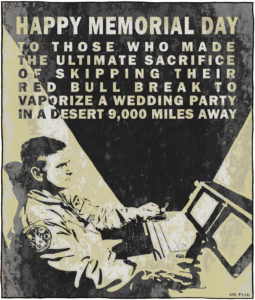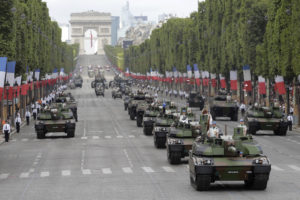Who Do We Remember on Memorial Day?
The first Memorial Day was called “Decoration Day.” The Soldiers & Sailors Monument stands behind the Memorial Day Flag Garden on Boston Common, Saturday, May 27, 2023, in Boston. The more than 37,000 flags are placed to honor Massachusetts soldiers who have died in service since the Revolutionary War. (AP Photo/Michael Dwyer)
The Soldiers & Sailors Monument stands behind the Memorial Day Flag Garden on Boston Common, Saturday, May 27, 2023, in Boston. The more than 37,000 flags are placed to honor Massachusetts soldiers who have died in service since the Revolutionary War. (AP Photo/Michael Dwyer)
On May 5, 1868, commander-in-chief of a Union veterans’ organization Gen. John A. Logan announced the creation of a new holiday. It was designed, he said, as “for the purpose of strewing with flowers or otherwise decorating the graves of comrades who died in defense of their country during the late rebellion, and whose bodies now lie in almost every city, village, and hamlet churchyard in the land.”
He called his new holiday “Decoration Day.”
In the South, the holiday was fraught. In 1874, the Georgia legislature decreed the celebration of Confederate Memorial Day. In 1916, several Southern states celebrated Confederate Memorial Day on June 3, the birthday of Confederate leader Jefferson Davis.
Black soldiers, many former slaves, honored the Union dead:
During the final year of the war, the Confederates had converted the city’s Washington Race Course and Jockey Club into an outdoor prison. Union captives were kept in horrible conditions in the interior of the track; at least 257 died of disease and were hastily buried in a mass grave behind the grandstand.
After the Confederate evacuation of Charleston black workmen went to the site, reburied the Union dead properly, and built a high fence around the cemetery. They whitewashed the fence and built an archway over an entrance on which they inscribed the words, “Martyrs of the Race Course.”
Union captives were kept in horrible conditions in the interior of the track; at least 257 died of disease and were hastily buried in a mass grave behind the grandstand.
After the World Wars of the 20th century, the holiday expanded to include all members of the U.S. military who died in service.
The first Decoration Day was chosen because early spring is a good time to honor the war dead with fresh flowers — and because it didn’t fall on the anniversary of any one battle. The holiday belongs to all who died in war. Still, the most visible manifestations are the soldiers felled in battle: Young, heroic. honorable.
Other war martyrs tend to be less prominent. Writing in The New York Times, Kayla M. Williams, a former assistant secretary in the Department of Veterans Affairs, remembers the unseen victims of war. Williams tells readers about Edith Ayres and Helen Burnett Wood. The two Army nurses were killed by shrapnel when a Navy gun exploded on a boat headed to Europe during World War 1. Even though they’d been inducted into the Army, they served without official title or commission — the Army didn’t know how to formally incorporate women into its ranks. “They probably are not among those who spring to mind when we imagine American military deaths in that war, yet they made the ultimate sacrifice in service to the nation while on their way to save lives,” Williams writes.
A more recent example, much closer to me, is someone I served with in the 101st Airborne Division. While I worked in signals intelligence in Iraq, my friend Alyssa Peterson worked in human intelligence. In 2003, near Mosul, she killed herself, and though her name is recorded on lists of those who died in Operation Iraqi Freedom, deaths like hers are often viewed differently from those in combat, perhaps because of the stigma attached to suicide.
While I worked in signals intelligence in Iraq, my friend Alyssa Peterson worked in human intelligence. In 2003, near Mosul, she killed herself
And what of veterans who end their lives after they have returned? In 2020, more than 6,100 veterans died by suicide. Last year, Dean Lambert wrote in Military Times about the suicide of his son, Adam, a Marine who died a year after returning home from Afghanistan. “When I found him lifeless, wearing his desert combat uniform, clutching his dog tags in his left hand, there was no doubt he brought the war back with him,” Mr. Lambert wrote. Memorial Day, he argued, should be for “remembering not only the heroes who lost their lives from physical wounds, but those who also died fighting mental injuries they sustained on the same battlefields.”
On social media, users shared their memories of individual soldiers. “Dear CJ – we love and miss you. On December 21, 2015, CJ was killed while conducting a joint patrol outside Bagram Air Base,” wrote one member. “I’ve always said that CJ is a real life superhero, and I will honor his legacy for the rest of my life. Happy #MemorialDay.”
“From Kennesaw, Georgia. Killed by enemy fire, Balad, Iraq, April 10th, 2004. Buried at Lincoln Cemetery, Atlanta, Georgia,” another user posted. “Antoine was 20 years old, leaving behind his wife and infant daughter when he deployed with his unit from Italy. We will always remember him. #MemorialDay”
On this Memorial Day, let’s also honor the civilian victims and refugees.
Your support matters…Independent journalism is under threat and overshadowed by heavily funded mainstream media.
You can help level the playing field. Become a member.
Your tax-deductible contribution keeps us digging beneath the headlines to give you thought-provoking, investigative reporting and analysis that unearths what's really happening- without compromise.
Give today to support our courageous, independent journalists.






You need to be a supporter to comment.
There are currently no responses to this article.
Be the first to respond.